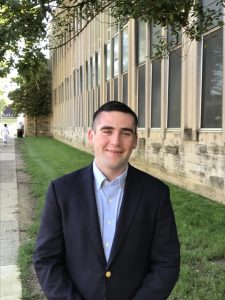
Nick O’Malley ’19
As a lifeguard on Long Island last summer, aspiring pediatrician Nick O’Malley ’19 made sure to spend extra time helping children with special needs, some of whom had Autism Spectrum Disorder (ASD). This year, he is staying in Philadelphia as a Summer Scholar to begin work on research that aims to discover if TimeSlips, a storytelling therapy developed for patients with Alzheimer’s disease, can lessen anxiety and increase social interaction in children with ASD.
“I always had a passion for helping people with intellectual or physical disabilities,” says the interdisciplinary health services major and varsity rower from Floral Park, New York. “This project is a great way to continue this passion in a manner that might leave lasting results.”
When O’Malley’s advisor Eileen Sullivan, Pharm.D., assistant professor of health services — who has researched the effects of TimeSlips on dementia patients and found that it decreased their agitation and anxiety — told him that another health services professor, Anne Fetherston, Ph.D., would embark on novel research focusing the same therapy on children with ASD, O’Malley jumped at the chance to get involved.
TimeSlips is based in the improvisation, imagination and spontaneity that develop when dementia or Alzheimer’s patients are given a photograph they haven’t seen before — for example, a woman playing a guitar, and then they begin to tell the woman’s story. As the story progresses, anxiety and isolation decrease, and pleasant interaction with caregivers increases. Patients focus on the enjoyment that using their creativity brings, instead of the realization that their memory is failing.
Fetherston, a Board-Certified Behavior Analyst-Doctoral (BCBA-D) who has provided interventions based on Applied Behavior Analysis principles to multiple populations, including individuals with autism, became intrigued by Sullivan’s findings and wondered if TimeSlips could produce the same positive results in the autism community.
“People with Alzheimer’s or dementia present with social deficits and behavioral excesses such as anxious and disruptive behaviors,” says Fetherston. “Likewise, individuals with autism have deficits in social skills and often display challenging behaviors, including anxiety-based responses that impede development of social interactions and relationships. Given that TimeSlips has been effective in ameliorating the problem behaviors of people with Alzheimer’s, we hypothesize that it will be an effective intervention for similar behaviors in people with ASD.”
While O’Malley and Fetherston are still in the early stages of designing the study, which will continue into the academic year, O’Malley says that the project has received approval to involve children with ASD who attend programs at SJU’s Kinney Center for Autism Education and Support.
“Nick is very committed to developing this research,” says Fetherston. “He has been pouring over literature to locate the background information supporting our hypothesis. The development of a line of research is an arduous task and Nick has displayed a strong commitment to making it successful.”
“I’m really lucky to be doing this work,” says O’Malley. “ASD is a huge public health issue, but many doctors don’t know much about it — they usually refer patients to other experts. I have a long road to go before I’m a pediatrician, but in my view, because we don’t have a cure for autism, it’s beneficial for everyone in healthcare to have more awareness about the disorder.”
Project Title: Examining the Effect of TimeSlips Therapy on Anxiety and Social Interaction of Individuals on the Autism Spectrum.
Mentor: Anne Fetherston, Ph.D., BCBA-D
Hometown: Floral Park, New York
Follow @sjuartssciences & @haubschool on Twitter to learn about this year’s summer scholars. #SJUSSP
